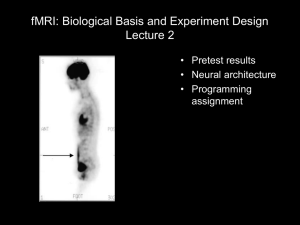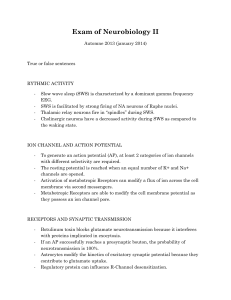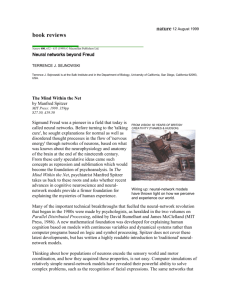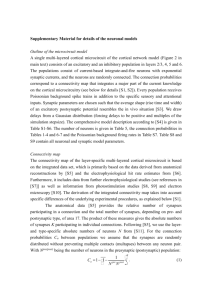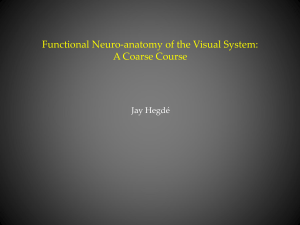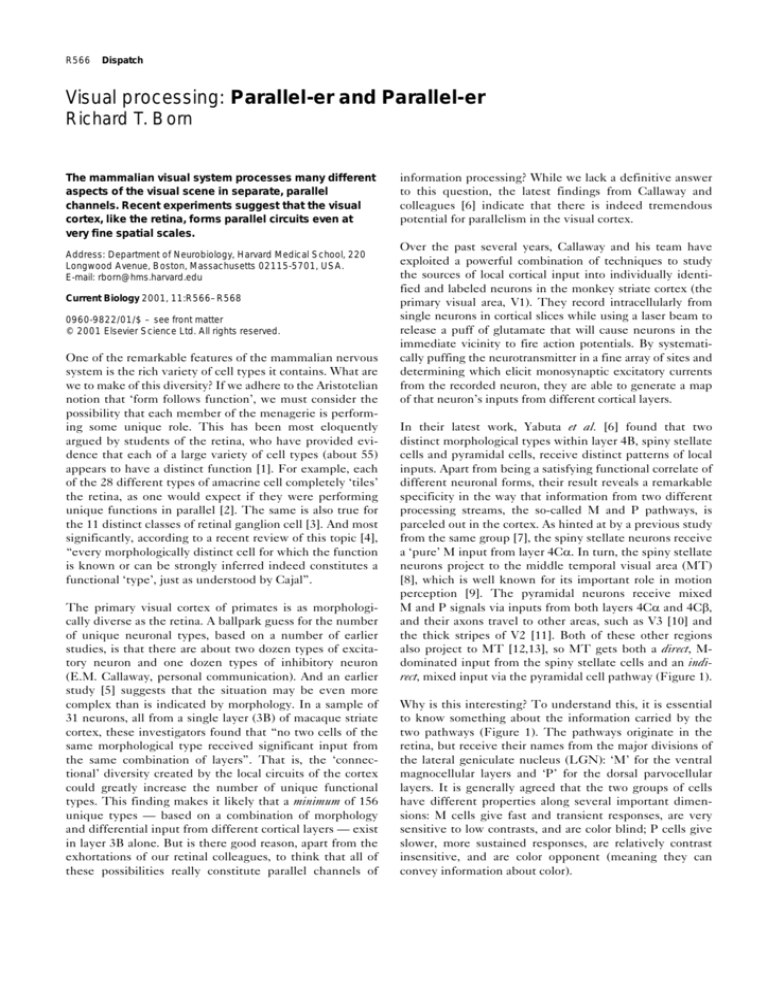
R566
Dispatch
Visual processing: Parallel-er and Parallel-er
Richard T. Born
The mammalian visual system processes many different
aspects of the visual scene in separate, parallel
channels. Recent experiments suggest that the visual
cortex, like the retina, forms parallel circuits even at
very fine spatial scales.
Address: Department of Neurobiology, Harvard Medical School, 220
Longwood Avenue, Boston, Massachusetts 02115-5701, USA.
E-mail: rborn@hms.harvard.edu
Current Biology 2001, 11:R566–R568
0960-9822/01/$ – see front matter
© 2001 Elsevier Science Ltd. All rights reserved.
One of the remarkable features of the mammalian nervous
system is the rich variety of cell types it contains. What are
we to make of this diversity? If we adhere to the Aristotelian
notion that ‘form follows function’, we must consider the
possibility that each member of the menagerie is performing some unique role. This has been most eloquently
argued by students of the retina, who have provided evidence that each of a large variety of cell types (about 55)
appears to have a distinct function [1]. For example, each
of the 28 different types of amacrine cell completely ‘tiles’
the retina, as one would expect if they were performing
unique functions in parallel [2]. The same is also true for
the 11 distinct classes of retinal ganglion cell [3]. And most
significantly, according to a recent review of this topic [4],
“every morphologically distinct cell for which the function
is known or can be strongly inferred indeed constitutes a
functional ‘type’, just as understood by Cajal”.
The primary visual cortex of primates is as morphologically diverse as the retina. A ballpark guess for the number
of unique neuronal types, based on a number of earlier
studies, is that there are about two dozen types of excitatory neuron and one dozen types of inhibitory neuron
(E.M. Callaway, personal communication). And an earlier
study [5] suggests that the situation may be even more
complex than is indicated by morphology. In a sample of
31 neurons, all from a single layer (3B) of macaque striate
cortex, these investigators found that “no two cells of the
same morphological type received significant input from
the same combination of layers”. That is, the ‘connectional’ diversity created by the local circuits of the cortex
could greatly increase the number of unique functional
types. This finding makes it likely that a minimum of 156
unique types — based on a combination of morphology
and differential input from different cortical layers — exist
in layer 3B alone. But is there good reason, apart from the
exhortations of our retinal colleagues, to think that all of
these possibilities really constitute parallel channels of
information processing? While we lack a definitive answer
to this question, the latest findings from Callaway and
colleagues [6] indicate that there is indeed tremendous
potential for parallelism in the visual cortex.
Over the past several years, Callaway and his team have
exploited a powerful combination of techniques to study
the sources of local cortical input into individually identified and labeled neurons in the monkey striate cortex (the
primary visual area, V1). They record intracellularly from
single neurons in cortical slices while using a laser beam to
release a puff of glutamate that will cause neurons in the
immediate vicinity to fire action potentials. By systematically puffing the neurotransmitter in a fine array of sites and
determining which elicit monosynaptic excitatory currents
from the recorded neuron, they are able to generate a map
of that neuron’s inputs from different cortical layers.
In their latest work, Yabuta et al. [6] found that two
distinct morphological types within layer 4B, spiny stellate
cells and pyramidal cells, receive distinct patterns of local
inputs. Apart from being a satisfying functional correlate of
different neuronal forms, their result reveals a remarkable
specificity in the way that information from two different
processing streams, the so-called M and P pathways, is
parceled out in the cortex. As hinted at by a previous study
from the same group [7], the spiny stellate neurons receive
a ‘pure’ M input from layer 4Cα. In turn, the spiny stellate
neurons project to the middle temporal visual area (MT)
[8], which is well known for its important role in motion
perception [9]. The pyramidal neurons receive mixed
M and P signals via inputs from both layers 4Cα and 4Cβ,
and their axons travel to other areas, such as V3 [10] and
the thick stripes of V2 [11]. Both of these other regions
also project to MT [12,13], so MT gets both a direct, Mdominated input from the spiny stellate cells and an indirect, mixed input via the pyramidal cell pathway (Figure 1).
Why is this interesting? To understand this, it is essential
to know something about the information carried by the
two pathways (Figure 1). The pathways originate in the
retina, but receive their names from the major divisions of
the lateral geniculate nucleus (LGN): ‘M’ for the ventral
magnocellular layers and ‘P’ for the dorsal parvocellular
layers. It is generally agreed that the two groups of cells
have different properties along several important dimensions: M cells give fast and transient responses, are very
sensitive to low contrasts, and are color blind; P cells give
slower, more sustained responses, are relatively contrast
insensitive, and are color opponent (meaning they can
convey information about color).
Dispatch
R567
Figure 1
V1
MT
1
LGN
2/3
P
Pyramidal
cell
Spiny stellate
cell
4A
4B
4Cα
M
4Cβ
V2
Direct
pathway
5
6
Indirect
pathway
Current Biology
Two parallel routes to visual area MT. Information from two different
processing streams converges in striate cortex (V1). The streams take
their initials from the ventral ‘magnocellular’ (M) and dorsal
‘parvocellular’ (P) layers of the lateral geniculate nucleus (LGN), shown
here in a Nissl stain of a coronal section [20]. Two routes by which the
information in these two streams might arrive at MT are shown in red
(indirect route) or black (direct route). The M cells project to layer 4Cα
of V1, which projects to both pyramidal (red) and spiny stellate (black)
cells of layer 4B. The P cells project to layer 4Cβ and then to the
pyramidal cells (but not the spiny stellate cells) of layer 4B. The spiny
stellate cells send their M-dominated signals directly to MT, which is
distinguished from surrounding areas by its heavy myelination [21]. The
pyramidal cells relay their presumably mixed M and P signals to MT
indirectly via either the thick stripes of V2, revealed by staining for
cytochrome oxidase [22], or V3 (not shown). The diagrams of the
pyramidal and spiny stellate cells are modified from images available at:
http://retina.umh.es/Webvision/imageswv/BasicCells.jpg;
WEBVISION: The organization of the vertebrate retina; Helga Kolb,
Eduardo Fernandez, and Ralph Nelson.
There is considerable debate on how cleanly segregated
these two streams remain at higher levels of the visual
pathways (see [14,15] for overviews). One point frequently
lost in the heat of this debate is that mixing of the two
functional streams does not mean that parallel processing is
not occurring at later stages — it may simply be organized
along different dimensions than ‘pure M’ versus ‘pure P’.
It would seem that one good reason for segregating certain
functional types is so that the information they convey can
be recombined in precise ways according to the demands
of a particular task. Consider a culinary analogy: the chef
desires orderly segregation of the various spices in his
kitchen, not so that he may make an entire meal of one or
another spice, but rather so that different spices can be
mixed in precise ways in order to yield new and interesting
flavors. He will have multiple levels of segregation: pure
spices, such as cardamom, along with specific combinations of spices, such as for a curry, which may in turn be
components of complete recipes.
specificities — the functions of which might be degraded
by P input. This is certainly possible and quite testable, as
pointed out by the authors, using combinations of anatomical tracers and functional labeling of cortical columns.
Indeed, the tremendous specificity in the mixing of M and
P streams discovered by Yabuta et al. [6] suggests that something interesting is cooking. But what? What might be the
function of this particular instance of micro-parallelism?
The authors speculate that the pure M pathway to MT
might provide inputs to a specific set of ‘columns’ — vertically organized sets of neurons with related response
We have recently found that MT neurons do indeed
‘solve’ the aperture problem [16], but the solution takes
time. It appears that these neurons initially derive a rough
estimate of direction by averaging all of the local motion
signals, and subsequently refine this estimate over the
ensuing 100 milliseconds. Interestingly, this process is
reflected both in the perception of such stimuli [17] and in
Another possibility, however, is that the parallel sources of
input to MT provide different types of information to the
same MT neurons. To see how and why this might play
out, consider a problem whose solution requires the integration of motion information, such as the ‘aperture problem’
(Figure 2). If a vertically oriented bar moves downward and
rightward at a constant velocity, a tiny V1 receptive field
positioned along the length of the contour can ‘see’ only the
rightward component of motion. Only a receptive field positioned over one of the endpoints of the bar, or ‘terminators’,
can measure the motion direction accurately. Thus solving
the aperture problem ultimately involves selecting terminator motion and ignoring, or at least reinterpreting, the
ambiguous measurements made along the contour.
R568
Current Biology Vol 11 No 14
Figure 2
References
1
2.
3.
4.
C
?
5.
6.
7.
T
8.
Current Biology
9.
The aperture problem. For a vertical bar (red) moving downwards and
to the right, a V1 neuron with a small receptive field positioned along
the contour (C) can measure only the rightward component of motion.
This measurement is consistent with many possible directions of actual
bar motion (?), and is therefore ambiguous. Only neurons whose
receptive fields are positioned over the bar’s terminators (T) can
measure the direction of motion accurately.
10.
11.
12.
eye movements used to track them [16,18]. These observations might be explained by a fast, but ‘dumb’ channel
(perhaps the M-dominated pathway from V1 to MT?)
which quickly gets things moving in the right general
direction (for example, the eyes during visual tracking),
followed by the more time-consuming integration of additional, highly selective information (such as the directional
signals from terminators, perhaps via V2 or V3?) to converge on the correct direction of motion. If this is the case,
selective inactivation of one or both of the indirect pathways might be expected to eliminate the iterative solution
found in MT neurons.
This is obviously speculative, as we do not yet know the
exact nature of the visual signals carried by the direct
versus indirect pathways to MT. It is clear that the spiny
stellate cells — the population characterized by Movshon
and Newsome [19], who identified them by antidromic
(that is, backwards) activation from MT — comprise a
very homogeneous class of direction-selective ‘special
complex’ cells. It would be especially interesting, though
heroic, to similarly characterize the pyramidal neurons in
layer 4B by using antidromic stimulation from V3, or the
thick stripes of V2, or both. Only heroic efforts of this
kind will ultimately tell us whether the beautiful piece of
anatomy described by Yabuta et al. [6] has important functional consequences. Almost certainly, it does. It would
seem uncharacteristically profligate of nature to squander
such precision.
13.
14.
15.
16.
17.
18.
19.
20.
21.
22.
Masland RH: Neuronal diversity in the retina. Curr Opin Neurobiol
2001, in press.
MacNeil MA, Masland RH: Extreme diversity among amacrine cells:
implications for function. Neuron 1998, 20:971-982.
Devries SH, Baylor DA: Mosaic arrangement of ganglion cell
receptive fields in rabbit retina. J Neurophysiol 1997,
78:2048-2060.
Masland RH, Raviola E: Confronting complexity: strategies for
understanding the microcircuitry of the retina. Annu Rev Neurosci
2000, 23:249-284.
Sawatari A, Callaway EM: Diversity and cell type specificity of local
excitatory connections to neurons in layer 3B of monkey primary
visual cortex. Neuron 2000, 25:459-471.
Yabuta NH, Sawatari A, Callaway EM: Two functional channels from
primary visual cortex to dorsal visual cortical areas. Science 2001,
292:297-300.
Sawatari A, Callaway EM: Convergence of magno- and
parvocellular pathways in layer 4B of macaque primary visual
cortex. Nature 1996, 380:442-446.
Shipp S, Zeki S: The organization of connections between areas
V5 and V1 in macaque monkey visual cortex. Eur J Neurosci 1989,
1:309-332.
Newsome WT, Salzman CD: The neuronal basis of motion
perception. Ciba Found Symp 1993, 174:217-230; discussion
230-246.
Burkhalter A, Felleman DJ, Newsome WT, Van Essen DC: Anatomical
and physiological asymmetries related to visual areas V3 and VP
in macaque extrastriate cortex. Vision Res 1986, 26:63-80.
Levitt JB, Yoshioka T, Lund JS: Intrinsic cortical connections in
macaque visual area V2: evidence for interaction between
different functional streams. J Comp Neurol 1994, 342:551-570.
Maunsell JH, Van Essen DC: The connections of the middle
temporal visual area (MT) and their relationship to a cortical
hierarchy in the macaque monkey. J Neurosci 1983, 3:2563-2586.
DeYoe EA, Van Essen DC: Segregation of efferent connections and
receptive field properties in visual area V2 of the macaque. Nature
1985, 317:58-61.
Livingstone MS, Hubel DH: Segregation of form, color, movement,
and depth: anatomy, physiology, and perception. Science 1988,
240:740-749.
Merigan WH, Maunsell JH: How parallel are the primate visual
pathways? Annu Rev Neurosci 1993, 16:369-402.
Pack CC, Born RT: Temporal dynamics of a neural solution to the
aperture problem in visual area MT of macaque brain. Nature
2001, 409:1040-1042.
Lorençeau J, Shiffrar M, Wells N, Castet E: Different motion
sensitive units are involved in recovering the direction of moving
lines. Vision Res 1993, 33:1207-1217.
Masson GS, Rybarczyk Y, Castet E, Mestre DR: Temporal dynamics
of motion integration for the initiation of tracking eye movements
at ultra-short latencies. Vis Neurosci 2000, 17:753-767.
Movshon JA, Newsome WT: Visual response properties of striate
cortical neurons projecting to area MT in macaque monkeys.
J Neurosci 1996, 16:7733-7741.
Hubel DH: Eye, Brain, and Vision. New York: Scientific American
Library; 1988.
Allman JM, Kaas JH: A representation of the visual field in the
caudal third of the middle temporal gyrus of the owl monkey
(aotus trivirgatus). Brain Res 1971, 31:85-105.
Hubel DH, Livingstone MS: Segregation of form, color, and
stereopsis in primate area 18. J Neurosci 1987, 7:3378-3415.

